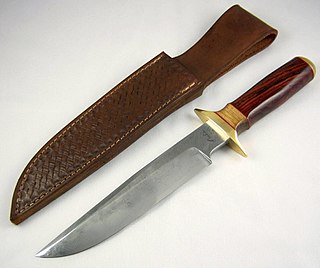
A knife is a tool or weapon with a cutting edge or blade, usually attached to a handle or hilt. One of the earliest tools used by humanity, knives appeared at least 2.5 million years ago, as evidenced by the Oldowan tools. Originally made of wood, bone, and stone, over the centuries, in step with improvements in both metallurgy and manufacturing, knife blades have been made from copper, bronze, iron, steel, ceramic, and titanium. Most modern knives have either fixed or folding blades; blade patterns and styles vary by maker and country of origin.

An adjustable spanner, shifting spanner or adjustable wrench is any of various styles of spanner (wrench) with a movable jaw, allowing it to be used with different sizes of fastener head rather than just one fastener size, as with a conventional fixed spanner.
A crusher is a machine designed to reduce large rocks into smaller rocks, gravel, sand or rock dust.
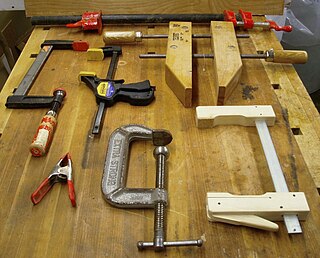
A clamp is a fastening device used to hold or secure objects tightly together to prevent movement or separation through the application of inward pressure. In the United Kingdom the term cramp is often used instead when the tool is for temporary use for positioning components during construction and woodworking; thus a G cramp or a sash clamp but a wheel clamp or a surgical clamp.

A blade is the portion of a tool, weapon, or machine with an edge that is designed to puncture, chop, slice or scrape surfaces or materials. Blades are typically made from materials that are harder than those they are to be used on. Historically, humans have made blades from flaking stones such as flint or obsidian, and from various metal such as copper, bronze, and iron. Modern blades are often made of steel or ceramic. Blades are one of humanity's oldest tools, and continue to be used for combat, food preparation, and other purposes.

Beveled glass is usually made by taking thick glass and creating an angled surface cut (bevel) around the entire periphery. Bevels act as prisms in sunlight creating an interesting color refraction which both highlights the glass work and provides a spectrum of colors which would ordinarily be absent in clear float glass.

Pliers are a hand tool used to hold objects firmly, possibly developed from tongs used to handle hot metal in Bronze Age Europe. They are also useful for bending and physically compressing a wide range of materials. Generally, pliers consist of a pair of metal first-class levers joined at a fulcrum positioned closer to one end of the levers, creating short jaws on one side of the fulcrum, and longer handles on the other side. This arrangement creates a mechanical advantage, allowing the force of the grip strength to be amplified and focused on an object with precision. The jaws can also be used to manipulate objects too small or unwieldy to be manipulated with the fingers.

Forceps are a handheld, hinged instrument used for grasping and holding objects. Forceps are used when fingers are too large to grasp small objects or when many objects need to be held at one time while the hands are used to perform a task. The term "forceps" is used almost exclusively in the fields of biology and medicine. Outside biology and medicine, people usually refer to forceps as tweezers, tongs, pliers, clips or clamps.

A kitchen knife is any knife that is intended to be used in food preparation. While much of this work can be accomplished with a few general-purpose knives – notably a large chef's knife, a tough cleaver, a small paring knife and some sort of serrated blade – there are also many specialized knives that are designed for specific tasks. Kitchen knives can be made from several different materials.
Diagonal pliers are pliers intended for the cutting of wire. The plane defined by the cutting edges of the jaws intersects the joint rivet at an angle or "on a diagonal", hence the name.

A noseband is the part of a horse's bridle that encircles the nose and jaw of the horse. In English riding, where the noseband is separately attached to its own headstall or crownpiece, held independently of the bit, it is often called a cavesson or caveson noseband. In other styles of riding, a simple noseband is sometimes attached directly to the same headstall as the bit.

A vise or vice is a mechanical apparatus used to secure an object to allow work to be performed on it. Vises have two parallel jaws, one fixed and the other movable, threaded in and out by a screw and lever.

A glass knife is a knife with a blade made of glass, with a fracture line forming an extremely sharp cutting edge.
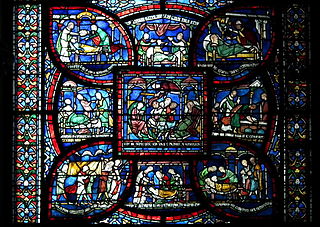
Came glasswork is the process of joining cut pieces of art glass through the use of came strips or foil into picturesque designs in a framework of soldered metal.
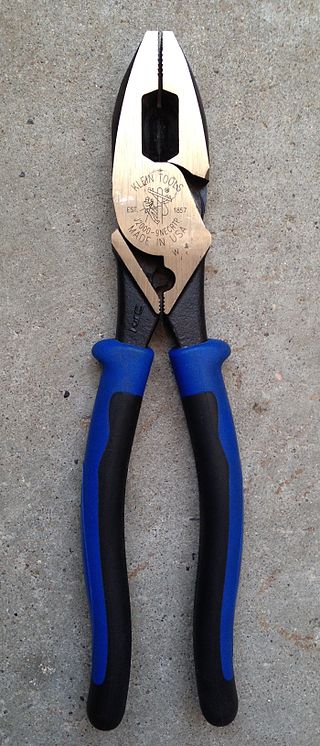
Lineman's pliers, Kleins, linesman pliers, side cutting linesman pliers and combination pliers are a type of pliers used by linemen, electricians, and other tradesmen primarily for gripping, twisting, bending and cutting wire, cable, and small metalwork components. They owe their effectiveness to their plier design, which multiplies force through leverage.

Rippled glass refers to textured glass with marked surface waves. Louis Comfort Tiffany made use of such textured glass to represent, for example, water or leaf veins.

Laminated glass is a type of safety glass consisting of two or more layers of glass with one or more thin polymer interlayers between them which prevent the glass from breaking into large sharp pieces. Breaking produces a characteristic "spider web" cracking pattern when the impact is not enough to completely pierce the glass.
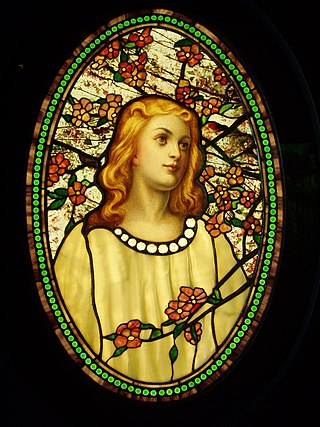
Tiffany glass refers to the many and varied types of glass developed and produced from 1878 to 1933 at the Tiffany Studios in New York City, by Louis Comfort Tiffany and a team of other designers, including Clara Driscoll, Agnes F. Northrop, and Frederick Wilson.
A glass cutter is a tool used to make a shallow score in one surface of a piece of glass that is to be broken in two pieces, for example to fit a window. The scoring makes a split in the surface of the glass which encourages the glass to break along the score. This is not to be confused with the tools used to make cut glass objects.
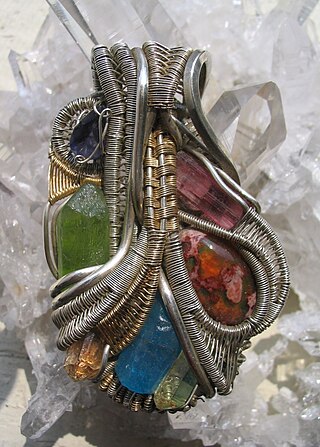
Wire wrapping is one of the oldest techniques for making handmade jewelry. This technique is done with jewelry wire and findings similar to wire to make components. Wire components are then connected to one another using mechanical techniques with no soldering or heating of the wire. Frequently, in this approach, a wire is bent into a loop or other decorative shape and then the wire is wrapped around itself to finish the wire component. This makes the loop or decorative shape permanent. The technique of wrapping wire around itself gives this craft its name of wire wrapping.

















